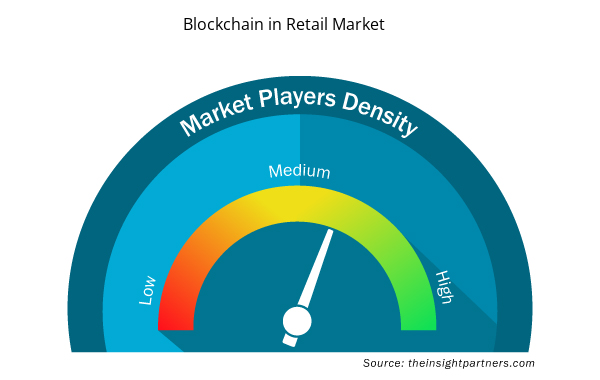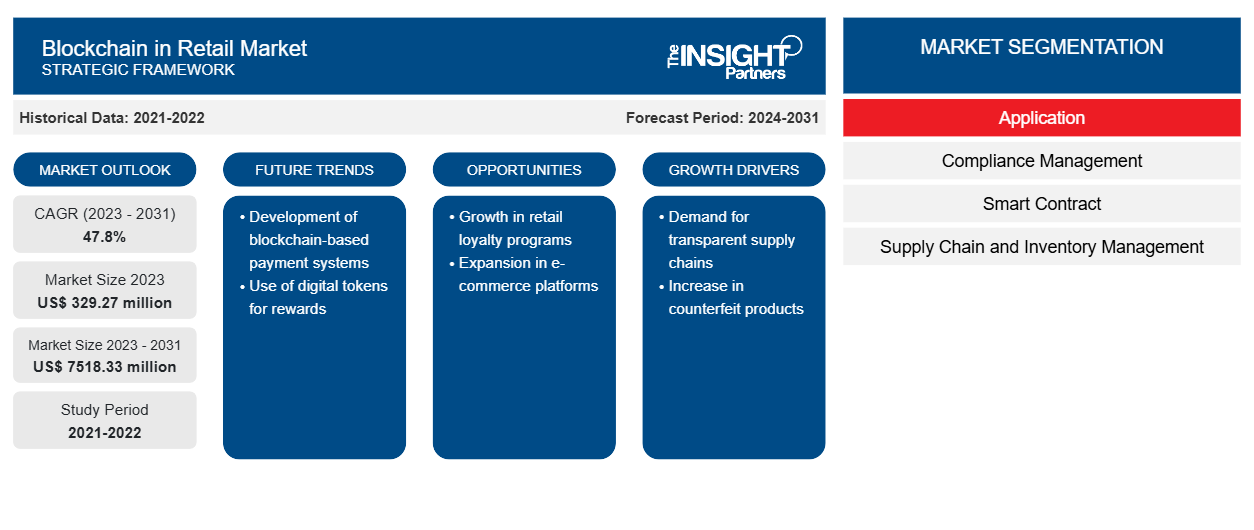小売業におけるブロックチェーンの市場規模は、2023 年の 3 億 2,927 万米ドルから 2031 年には 7 億 5,1833 万米ドルに成長すると予想されており、2023 年から 2031 年にかけて 47.8% の CAGR で拡大すると予想されています。ブロックチェーンは、ネットワーク全体で共有される不変の台帳またはデジタル記録であり、サービスとプロセスを最適化するツールと見なされることがよくあります。資産の追跡であれ、より一般的には取引の文書化であれ、ブロックチェーンは、その大きな可能性により、特に金融分野で人気が高まり続けています。
小売市場分析におけるブロックチェーン
小売市場におけるブロックチェーンの予測は、主要な企業出版物、協会データ、データベースなど、さまざまな二次および一次調査結果に基づいて推定されています。ブロックチェーンは、店舗にデータの保護、整理、共有のためのより優れた方法を提供します。商人、消費者、メーカー間の透明性が高まると、信頼性、柔軟性、およびサービス オプションの選択肢が広がります。小売業でブロックチェーンを使用すると、製品のすべての動きを記録でき、さらに良いことに、これらの動きを卸売業者と小売業者が追跡できます。全体として、システム管理は効率的で簡素化されており、元帳はネットワーク上に保持され、関係者全員が簡単にアクセスできます。小売業のスピードと業界の急成長、そして高まる顧客の需要の絶え間ない変化により、ブロックチェーンは望ましい選択肢となっています。このソリューションは、セキュリティと偽造の懸念、データ管理の障害、運用コストの大幅な削減など、業界のさまざまな問題に対処します。
小売業におけるブロックチェーン
業界概要
- ブロックチェーン技術は、パートナー間の潜在的な摩擦を軽減または排除することで、企業プロセスを改善できます。スマート コントラクトは、契約の実施を簡素化するのに役立ちます。事前に定義された契約上の義務が満たされると、契約条件が自動的に実行されます。
- 2019年、カルフールは、オーヴェルニュチキン、コーラリーナトマト、ルーエ農場産卵、ロカマドゥールAOCチーズ、ジロの新鮮な牛乳、ノルウェーサーモン、クリスマスチキンといったカルフールの高品質ラインにブロックチェーン技術を徐々に導入しました。消費者は商品ラベルのQRコードをスキャンすることで、スマートフォンで透明な情報を得ることができます。
- 大手小売企業は、サプライチェーン全体の問題を解決するためにブロックチェーン技術の適用に継続的に取り組んでおり、これが小売市場におけるブロックチェーンの推進力となっています。
要件に合わせてレポートをカスタマイズする
このレポートの一部、国レベルの分析、Excelデータパックなど、あらゆるレポートを無料でカスタマイズできます。また、スタートアップや大学向けのお得なオファーや割引もご利用いただけます。
- このレポートの主要な市場動向を入手してください。この無料サンプルには、市場動向から見積もりや予測に至るまでのデータ分析が含まれます。
小売市場の牽引役としてのブロックチェーン
ブロックチェーン技術を使用してサプライチェーンを合理化し、小売市場でブロックチェーンを推進する
- ブロックチェーンは、サプライ チェーン管理のアップグレードと最適化の強力な根拠となります。さまざまな方法でサプライ チェーンを変えることができます。このプラットフォームは、サプライ チェーン関係者間での効率的なデータ通信を促進し、第三者の必要性を排除します。データは共有デジタル データベース上で当事者間で記録、確認、更新、またはアクセスできるため、サプライ チェーン全体の出荷やその他の操作を明確に把握できます。仲介者を使用せずに安全なリアルタイム検証と取引を可能にすることで、当事者の合意に基づいて支払いを合理化し、迅速化します。
- IoT センサーとスマート デバイスをサプライ チェーンで使用すると、製品関連の要素 (温度や湿度など) を測定し、それをブロックチェーンに記録して問題を検出し、サプライ チェーンの運用への影響を完全に把握することができます。サプライ チェーンを構築するために専門的な IoT 開発が必要な場合は、当社の専門家が必要な知識を持っています。
小売業におけるブロックチェーン
市場レポートのセグメンテーション分析
- アプリケーションに基づいて、小売市場におけるブロックチェーンのレポートは、コンプライアンス管理、スマート コントラクト、サプライ チェーンと在庫管理、トランザクション管理、自動化された顧客サービス、および ID 管理に分類されます。スマートコントラクトセグメントは、2023 年にブロックチェーン小売市場で大きなシェアを占めると予想されています。
- ブロックチェーン テクノロジーは、コンプライアンス タスクやユーザー アクションの変更を記録する不変の監査証跡を作成できます。ブロックチェーンのエントリには、変更を行ったユーザー、日時、変更内容などの情報が含まれます。
小売業におけるブロックチェーン
地域別市場分析
小売市場におけるブロックチェーンレポートの範囲は、主に北米、ヨーロッパ、アジア太平洋、中東およびアフリカ、南米の 5 つの地域に分かれています。北米は急速な成長を遂げており、小売市場におけるブロックチェーンで大きなシェアを占めると予想されています。この地域のブロックチェーン分野における重要な技術開発がこの成長に貢献しています。北米には米国やカナダなどの多くの発展途上国があり、小売市場におけるブロックチェーンの成長を牽引しています。
小売業におけるブロックチェーン
市場レポートの範囲
小売市場におけるブロックチェーンの地域分析
予測期間を通じて小売市場におけるブロックチェーンに影響を与える地域的な傾向と要因は、Insight Partners のアナリストによって徹底的に説明されています。このセクションでは、北米、ヨーロッパ、アジア太平洋、中東、アフリカ、南米、中米にわたる小売市場におけるブロックチェーンのセグメントと地理についても説明します。

- 小売市場におけるブロックチェーンの地域別データを入手
小売市場におけるブロックチェーンレポートの範囲
| レポート属性 | 詳細 |
|---|---|
| 2023年の市場規模 | 3億2,927万米ドル |
| 2031年までの市場規模 | 75億1,833万ドル |
| 世界のCAGR(2023年~2031年) | 47.8% |
| 履歴データ | 2021-2022 |
| 予測期間 | 2024-2031 |
| 対象セグメント | アプリケーション別
|
| 対象地域と国 | 北米
|
| 市場リーダーと主要企業プロフィール |
|
市場プレーヤーの密度:ビジネスダイナミクスへの影響を理解する
小売市場におけるブロックチェーン市場は、消費者の嗜好の変化、技術の進歩、製品の利点に対する認識の高まりなどの要因により、エンドユーザーの需要が高まり、急速に成長しています。需要が高まるにつれて、企業は提供を拡大し、消費者のニーズを満たすために革新し、新たなトレンドを活用し、市場の成長をさらに促進しています。
市場プレーヤー密度とは、特定の市場または業界内で活動している企業または会社の分布を指します。これは、特定の市場スペースに、その市場規模または総市場価値に対してどれだけの競合相手 (市場プレーヤー) が存在するかを示します。
小売市場でブロックチェーンを展開している主要企業は次のとおりです。
- IBM
- アマゾン
- オラクル
- マイクロソフト
- SAP社
- ビットフューリー
免責事項:上記の企業は、特定の順序でランク付けされていません。

- 小売市場におけるブロックチェーンのトップキープレーヤーの概要を入手
「小売市場分析におけるブロックチェーン」コア投資戦略と地理に基づいて実施されました。アプリケーションの観点から、市場はコンプライアンス管理、スマートコントラクト、サプライチェーンと在庫管理、トランザクション管理、自動化された顧客サービス、およびアイデンティティ管理に分類されています。地理に基づいて、市場は北米、ヨーロッパ、アジア太平洋、中東およびアフリカ、南米に分類されています。
小売業におけるブロックチェーン
市場ニュースと最近の動向
小売業におけるブロックチェーン市場では、企業は合併や買収などの無機的および有機的な戦略を採用しています。最近の主要な市場動向をいくつか以下に示します。
- 2018年10月、IBMは18か月の開発期間を経て、ブロックチェーンベースの食品追跡ネットワークであるFood Trustを正式に発表した。同社は同じリリースで、別の大手食料品小売業者であるカルフールが同社のエコシステムに参加することを明らかにした。フランスに拠点を置き、33か国に12,000以上の店舗を持つこの企業は、各店舗でブロックチェーンのテストを開始する予定だ。
[出典: IBM、企業ウェブサイト]
小売業におけるブロックチェーン
市場レポートの対象範囲と成果物
市場レポート「小売業におけるブロックチェーンの市場規模と予測(2021〜2031年)」では、以下の分野を網羅した市場の詳細な分析を提供しています。
- 対象範囲に含まれるすべての主要市場セグメントについて、世界、地域、国レベルでの市場規模と予測。
- 推進要因、制約、主要な機会などの市場の動向。
- 今後の主な動向。
- 詳細なPESTおよびSWOT分析
- 主要な市場動向、主要プレーヤー、規制、最近の市場動向を網羅した世界および地域の市場分析。
- 市場集中、ヒートマップ分析、主要プレーヤー、最近の動向を網羅した業界の状況と競争分析。
- 詳細な企業プロフィール。
- 過去2年間の分析、基準年、CAGRによる予測(7年間)
- PEST分析とSWOT分析
- 市場規模価値/数量 - 世界、地域、国
- 業界と競争環境
- Excel データセット



Report Coverage
Revenue forecast, Company Analysis, Industry landscape, Growth factors, and Trends

Segment Covered
This text is related
to segments covered.

Regional Scope
North America, Europe, Asia Pacific, Middle East & Africa, South & Central America

Country Scope
This text is related
to country scope.
よくある質問
Product authentication and anti-counterfeiting are impacting blockchain in retail, which is anticipated to bring new blockchain in retail market trends in the coming years.
The key players holding majority shares in the global blockchain in the retail market are IBM, AWS, Oracle, Microsoft, and SAP.
The global blockchain in retail market was estimated to be US$ 329.27 million in 2023 and is expected to grow at a CAGR of 47.8% during the forecast period 2023 - 2031.
The global blockchain in the retail market is expected to reach US$ 7518.33 million by 2031.
The use of blockchain technology to streamline the supply chain and improve inventory management are the major factors that propel the global blockchain in retail market growth.
Trends and growth analysis reports related to Banking, Financial Services, and Insurance : READ MORE..
- IBM
- AWS
- Oracle
- Microsoft
- SAP
- Bitfury
- Sofocle
- Cegeka
- BitPay
- BigchainDB
The Insight Partners performs research in 4 major stages: Data Collection & Secondary Research, Primary Research, Data Analysis and Data Triangulation & Final Review.
- Data Collection and Secondary Research:
As a market research and consulting firm operating from a decade, we have published and advised several client across the globe. First step for any study will start with an assessment of currently available data and insights from existing reports. Further, historical and current market information is collected from Investor Presentations, Annual Reports, SEC Filings, etc., and other information related to company’s performance and market positioning are gathered from Paid Databases (Factiva, Hoovers, and Reuters) and various other publications available in public domain.
Several associations trade associates, technical forums, institutes, societies and organization are accessed to gain technical as well as market related insights through their publications such as research papers, blogs and press releases related to the studies are referred to get cues about the market. Further, white papers, journals, magazines, and other news articles published in last 3 years are scrutinized and analyzed to understand the current market trends.
- Primary Research:
The primarily interview analysis comprise of data obtained from industry participants interview and answers to survey questions gathered by in-house primary team.
For primary research, interviews are conducted with industry experts/CEOs/Marketing Managers/VPs/Subject Matter Experts from both demand and supply side to get a 360-degree view of the market. The primary team conducts several interviews based on the complexity of the markets to understand the various market trends and dynamics which makes research more credible and precise.
A typical research interview fulfils the following functions:
- Provides first-hand information on the market size, market trends, growth trends, competitive landscape, and outlook
- Validates and strengthens in-house secondary research findings
- Develops the analysis team’s expertise and market understanding
Primary research involves email interactions and telephone interviews for each market, category, segment, and sub-segment across geographies. The participants who typically take part in such a process include, but are not limited to:
- Industry participants: VPs, business development managers, market intelligence managers and national sales managers
- Outside experts: Valuation experts, research analysts and key opinion leaders specializing in the electronics and semiconductor industry.
Below is the breakup of our primary respondents by company, designation, and region:

Once we receive the confirmation from primary research sources or primary respondents, we finalize the base year market estimation and forecast the data as per the macroeconomic and microeconomic factors assessed during data collection.
- Data Analysis:
Once data is validated through both secondary as well as primary respondents, we finalize the market estimations by hypothesis formulation and factor analysis at regional and country level.
- Macro-Economic Factor Analysis:
We analyse macroeconomic indicators such the gross domestic product (GDP), increase in the demand for goods and services across industries, technological advancement, regional economic growth, governmental policies, the influence of COVID-19, PEST analysis, and other aspects. This analysis aids in setting benchmarks for various nations/regions and approximating market splits. Additionally, the general trend of the aforementioned components aid in determining the market's development possibilities.
- Country Level Data:
Various factors that are especially aligned to the country are taken into account to determine the market size for a certain area and country, including the presence of vendors, such as headquarters and offices, the country's GDP, demand patterns, and industry growth. To comprehend the market dynamics for the nation, a number of growth variables, inhibitors, application areas, and current market trends are researched. The aforementioned elements aid in determining the country's overall market's growth potential.
- Company Profile:
The “Table of Contents” is formulated by listing and analyzing more than 25 - 30 companies operating in the market ecosystem across geographies. However, we profile only 10 companies as a standard practice in our syndicate reports. These 10 companies comprise leading, emerging, and regional players. Nonetheless, our analysis is not restricted to the 10 listed companies, we also analyze other companies present in the market to develop a holistic view and understand the prevailing trends. The “Company Profiles” section in the report covers key facts, business description, products & services, financial information, SWOT analysis, and key developments. The financial information presented is extracted from the annual reports and official documents of the publicly listed companies. Upon collecting the information for the sections of respective companies, we verify them via various primary sources and then compile the data in respective company profiles. The company level information helps us in deriving the base number as well as in forecasting the market size.
- Developing Base Number:
Aggregation of sales statistics (2020-2022) and macro-economic factor, and other secondary and primary research insights are utilized to arrive at base number and related market shares for 2022. The data gaps are identified in this step and relevant market data is analyzed, collected from paid primary interviews or databases. On finalizing the base year market size, forecasts are developed on the basis of macro-economic, industry and market growth factors and company level analysis.
- Data Triangulation and Final Review:
The market findings and base year market size calculations are validated from supply as well as demand side. Demand side validations are based on macro-economic factor analysis and benchmarks for respective regions and countries. In case of supply side validations, revenues of major companies are estimated (in case not available) based on industry benchmark, approximate number of employees, product portfolio, and primary interviews revenues are gathered. Further revenue from target product/service segment is assessed to avoid overshooting of market statistics. In case of heavy deviations between supply and demand side values, all thes steps are repeated to achieve synchronization.
We follow an iterative model, wherein we share our research findings with Subject Matter Experts (SME’s) and Key Opinion Leaders (KOLs) until consensus view of the market is not formulated – this model negates any drastic deviation in the opinions of experts. Only validated and universally acceptable research findings are quoted in our reports.
We have important check points that we use to validate our research findings – which we call – data triangulation, where we validate the information, we generate from secondary sources with primary interviews and then we re-validate with our internal data bases and Subject matter experts. This comprehensive model enables us to deliver high quality, reliable data in shortest possible time.


 このレポートの無料サンプルを入手する
このレポートの無料サンプルを入手する